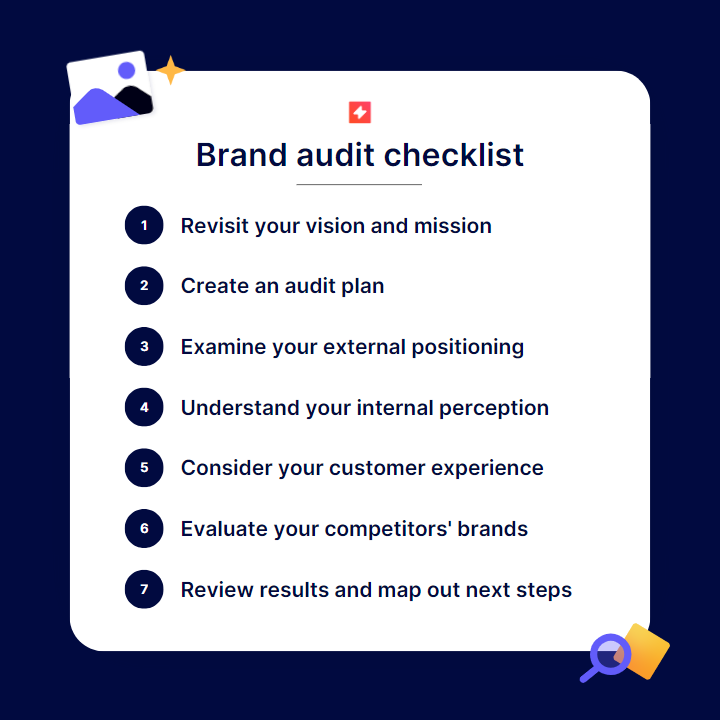Conducting a deep dive brand audit will enable you to step into your clients’, prospects’ and employees’ shoes to get an objective view of your company’s performance and positioning in the market. If you’re considering a brand refresh or full rebrand, a brand audit should always be the first step.
Read this blog to discover everything you need to know about a brand audit, the purpose of conducting one and how to do a brand audit in six easy steps.
Brand Audit: Summary and Benefits
What Is a Brand Audit?
A brand audit is a detailed analysis of your brand that enables you to uncover:
- Where your brand sits in the market
- What your strengths and weaknesses are
- Any risks or opportunities for growth strategies
- How your employees, customers and clients engage with and feel about your brand
- What your competitors are doing, their strengths and weaknesses and how you compare
Many external brand agencies can help you conduct a brand audit; however, if you plan carefully and secure the right internal resource you can do it yourself.
When to Conduct a Brand Audit?
There isn’t one-size-fits-all advice on when to initiate an audit process. As per industry experts, a brand audit should be performed at least once a year or during special events such as mergers, acquisitions, changing brand positions, or introducing new market segments. Key signs like dwindling customer loyalty or sales slump may also necessitate reevaluating brand strategies through an audit.
The Benefits of Conducting Regular Brand Audits
With an effective brand audit, you’ll be able to get an unbiased understanding of your company’s internal culture, decide how effective your external branding is, and evaluate your customer experience.
Performing a brand audit will enable you to determine concrete strategies to ensure your brand helps achieve business growth; maybe you’ll need to refresh your website and marketing collateral to better reflect your offering? Or perhaps you need to rework the customer journey?
How to Do a Brand Audit
1. Confirm Your Brand Mission
Before you embark on your brand audit, you need to be clear on your ultimate brand goal as that will act as your north star throughout the process. Many companies will refer to their go-to-market strategy or company missions and check how their brand performs against those.
Even if you’re mapping out a completely new strategy, or undergoing a rebrand, you’ll need to have a good idea of what this will be before you start your audit as that will determine the topics that need to be assessed throughout. For example, if you’re hoping to expand your business, recruitment might be part of your growth strategy. Therefore, you’ll need to analyze your employer brand perception throughout your audit.
Only once you’ve confirmed your business mission and strategic objectives can you begin creating the framework for your brand audit.
2. Create a Brand Audit Checklist
Now you know your mission, you’ll need to create a brand audit checklist and map out exactly what needs to be analyzed, how you’ll do it and whose insight you’ll rely on throughout the process. Your plan should center around three key areas:
- External branding (to discover how it’s perceived in the market)
- Internal culture (to ascertain if your employees and investors align with your mission)
- Customer and client experience (to uncover any potential misalignment with the brand)
You’ll also need to establish a rough timeline for when you’ll complete each stage of your brand audit.
Brand Audit Top Tip
Choose the most effective methods to collate qualitative and quantitative data
There are many different ways you can gather this insight, for example: setting up focus groups, anonymous surveys, social media polling and phone interviews.
3. Examine Your External Branding
One of the biggest challenges businesses face is when their visual identity doesn’t align with their strategic goals. There are many scenarios where this could be the case, for example:
- You haven’t updated your brand in ten years. It was fit-for-purpose for who you were back then, but it’s outdated and doesn’t reflect who you are now.
- There’s recently been a change in leadership who’d like to take the business in a completely different direction. Your current brand doesn’t align with this new vision.
How to Analyze Your External Branding
You’ll need to create focus groups of people from the branding team, senior board, and wider business who will provide insight from the inside.
You will also need to gather external perspectives from clients, prospects and your target demographic to get a broader perspective and discover how it’s perceived in the market.
First, start by evaluating whether your core visual assets, like logo, color palette and fonts reflect who you want to be as a brand. You could ask your focus groups questions like:
- How does our logo make you feel?
- What industry do you think this company operates in, based on the logo?
- What values do you think this logo represents?
- What do these colors say to you?
Be sure to dig deep into their answers to gather as much insight as possible.
When to Update Your Visual Identity
If the answers don’t align with how you’d like to be perceived as a business, you may need to consider updating some of the core elements of your visual identity, to better align with your strategic goals.
You should also evaluate how your external branding compares with your competitors’ visual identities. For example, if you’re a technology firm, look at your peers in this sector to see how your logo compares. Does it stand out? If so, for what reasons – good or bad? You can also think beyond just competitors – think about your personas and which other brands they favor in their daily lives, how do you compare with those as well?

When creating UpSlide’s new visual identity, I spoke with internal and external stakeholders from each territory that our business operates in. It’s important to incorporate the different cultures, traditions and competitors that exist in each country.
Florian Petitdemange
Design Lead

The next step is to look at your client-facing materials, like proposals, PowerPoint presentations and email templates. There’s often a gap between the documents that marketing creates and what clients actually receive. So, start by looking at the documents that are distributed by your teams.
If there’s a clear deviation from the marketing templates, you should speak to the teams creating client documents and dig into why this is happening. Usually, it’s either because the sales team haven’t bought into the brand, or they find it hard to use in practice. To fix this, you’ll need to establish ways of working with them to create more optimized, useable materials that will help to maintain a strong brand identity.
Take a look at our article on how to build a user-friendly PowerPoint template.
Rebranding Your Website or Social Media
Then, you can deep dive into the larger platforms like your website and social media to access audience demographic data. Ask yourself:
- How much traffic are we getting and what’s the split between new and returning visitors? Is it what we’d expect?
- Where is this traffic coming from? Which channels are bringing in the most visitors and how many people are searching for us directly?
- Where are our audiences, are they in the regions we focus on, or are there more visitors than expected from a particular region?
- How are people engaging with our content? Are they spending time on these pages or is there a high bounce rate?
Try to also identify any trends which have developed over time to see how your audience is evolving. If you are able to establish some reliable industry benchmarks this will also help you understand how these statistics compare with other firms in your industry. Based on all of this, you might identify opportunities you had not yet considered – such as the chance to tap into a new demographic, or risks that need addressing – such as poor engagement with your content or a lack of brand awareness.
Once you’ve gone through all your external branding with a fine-tooth comb, you’ll be able to flag what works, what needs optimizing, and what needs completely reinventing.

4. Understand Your Internal Branding
Nobody knows your business as well as your internal teams. You can rely on their insight to provide an accurate perspective on the existing culture, ethos, values and how these compare to what you think they are or would like them to be.
Running Internal Focus Groups
Again, using focus groups or dedicated brainstorming meetings, ask a select group of individuals, from a range of different departments and geographies, questions like:
- How would you describe our brand?
- What is the brand’s vision?
- What problem does our brand solve for customers?
- How would you improve our brand?
- How would you describe our culture?
- Where do you see our business in 3-5 years?
- Do the current marketing materials reflect our mission and values?
You can also use this to understand why your employees wanted to join the company. Conduct an eNPS (employee Net Promoter Score) survey and gather the insights to help identify your business’s strengths and weaknesses. You can then position these strengths as your USPs throughout the recruitment processes, and work on addressing the weaknesses identified with the relevant departments. This will help you to strengthen your employer brand and attract and retain talent better.
5. Consider Your Customer Experience
It’s essential to have a clear understanding of your entire customer experience so you can map out potential risks and opportunities. To gain this insight you should interview clients, prospects and employees to discover how your brand is presented at each stage of the customer journey – from initial sales demos to ongoing customer support.
Note down areas where you think you perform well – your impeccable customer service, for example, which could be emphasized more in your marketing materials to help you stand out against your competitors. But pay careful attention to your areas of weakness and try to find out as much detail as you can. Make sure you pass your findings on to the relevant teams in a constructive and useable way, so they can prioritize them and make the necessary improvements.
6. See How You Compare to Your Competitors’ Brands
Keeping an eye on your competitors and what they’re doing is challenging, but this is your chance to take stock and assess them in detail. Firstly, map out the competitive landscape. You’ll probably already be aware of most of your direct competitors (companies that offer the same services as you), but also list your partial competitors too (companies where there is slight cross-over in services/product offering).
Conduct a SWOT Analysis
Then you can complete a SWOT analysis for your business, as well as each competitor to figure out:
- What are your/their strengths?
- What are your/their weaknesses?
- Which opportunities do you/they have to grow their business?
- Which threats do you/they face in doing so?
You’ll better understand your position in the landscape, which will aid you when making strategic business decisions and investments.
Brand Audit Top Tip
Put your SWOT analysis for each competitor into a battlecard
Your sales teams can use these battlecards to remind them of the strengths and weaknesses of each business when competing against them in detail.
Outcomes of a Brand Audit
It’s been a long process, but you’ve finally reached the end of your brand audit. You know everything about your business: how it’s currently perceived in the market, where you want it to be, and what actions are required to get there. But where do you store all these findings? A cohesive brand audit report.
Best Practices for Implementing Changes Effectively
The brand audit will inevitably have left you with a large to-do list, and unfortunately, it’s not possible to tackle it all at once. You’ll need to prioritize the list first based on impact possibility and easy feasibility, and then get the relevant teams on board to establish the next steps. Incremental improvements often work better than drastic overhauls!
Key Takeaways and Useful Resources
Maybe it’s time to take the plunge and conduct a complete rebrand; reinventing everything from your core values to your visual identity. Or perhaps you’ve realized that you only need to optimize the marketing materials for your sales team.
Whatever the next steps are, always refer to the findings in your brand audit to aid you on your journey to make it a success.
If you want to know how UpSlide can help you ensure brand consistency across your Microsoft Office materials, get in touch.
Key Resources on Brand Audits, Rebranding and Brand Compliance
- 4 Mistakes to Avoid With Your Rebrand Launch
- The Financial Services Rebrand Playbook
- Strengthen Your Financial Services Brand Strategy
TL;DR
A brand audit is a comprehensive evaluation of a company’s brand to assess its current position, strengths, and weaknesses.
Conducting an audit helps businesses identify areas for improvement, enhance brand consistency, align marketing strategies, and ultimately strengthen their brand’s presence and competitiveness.
The seven key steps to conduct a brand audit include defining objectives, researching the market and competitors, evaluating brand elements, assessing brand perception, analyzing brand communications, measuring brand equity, and developing an action plan.









